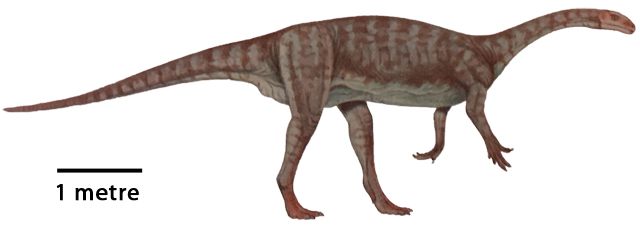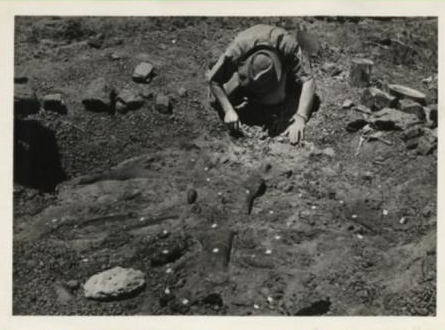Kholumolumo ellenbergerorum – A Dinosaur from a “Rubbish Dump”
Kholumolumo ellenbergerorum – A Dinosaur from a “Rubbish Dump”
This year (2020), saw the publication of a scientific paper describing a new species of Late Triassic non-sauropodan sauropodomorph from southern Africa. The dinosaur named Kholumolumo ellenbergerorum, at around nine to ten metres in length, was one of the largest animals living in that part of Gondwana during the Norian stage of the Triassic. Surprisingly, for such a big animal, the fossils indicate that this dinosaur was bipedal.
A Life Reconstruction of Kholumolumo ellenbergerorum

Picture credit: Everything Dinosaur
Fragmentary Fossils
The fragmentary fossils consisting of post-cranial material, including most notably, a robust lower leg bone (tibia), represent several individuals and these fossils first came to light in 1930, when Samuel Motsoane, a leading member of the Paris Evangelical Mission School located at Bethesda in Lesotho, found several disarticulated dinosaur bones.
It was not until 1955 that a formal survey and excavation of the area was carried out. Brothers Paul and François Ellenberger mapped and excavated a small area uncovering a mono-dominant bonebed representing numerous individuals. The dig took place behind the back of a hut, within a few metres of the village rubbish dump. Undeterred the brothers completed their work, publishing a preliminary description that year with a more detailed paper following in 1956 which was published by the French Geology Society (Societe Geologique de France).
A Rare Archive Made Available
The Maphutseng assemblage has been mentioned in several papers and named on two occasions but never formally published. Back in the spring, this omission was rectified and this dinosaur was finally formally scientifically described (Peyre de Fabrègues & Allain). Two months before the scientific paper came out, the UK Government Foreign and Commonwealth Office via The National Archives made available on-line thousands of rare images of Africa, showing a century of British involvement on the continent.
One of those black and white images in the Lesotho section showed a dinosaur fossil excavation. There was a photographic record of the “Maphutseng dinosaur”.
Excavating Dinosaur Fossils in Lesotho

Picture credit: Alwyn Bisschoff/The National Archives (catalogue reference Part of CO 1069/209)
The photograph (above), might be just one of thousands of rare images of Africa made available on-line by The National Archives in a project entitled “Africa Through a Lens”, but it shows (most likely), one of the Ellenberger brothers carefully exposing the Kholumolumo fossil material.
Everything Dinosaur is not aware of a photographic record of the rubbish dump being preserved for posterity.
Kholumolumo ellenbergerorum
Despite the large size of this taxon (around 9-10 metres in length), with an estimated body mass of approximately 1.7 tonnes, the researchers (Peyre de Fabrègues & Allain), did not think Kholumolumo was linked to the origin of the Sauropoda, an Order of the Dinosauria famous for consisting of the largest terrestrial vertebrates known to science.
Kholumolumo (pronounced Ko-lum-oh-loo-mo) is derived from the local Sotho dialect for a mythical reptilian beast, whilst the specific or trivial name honours the Ellenberger brothers.

